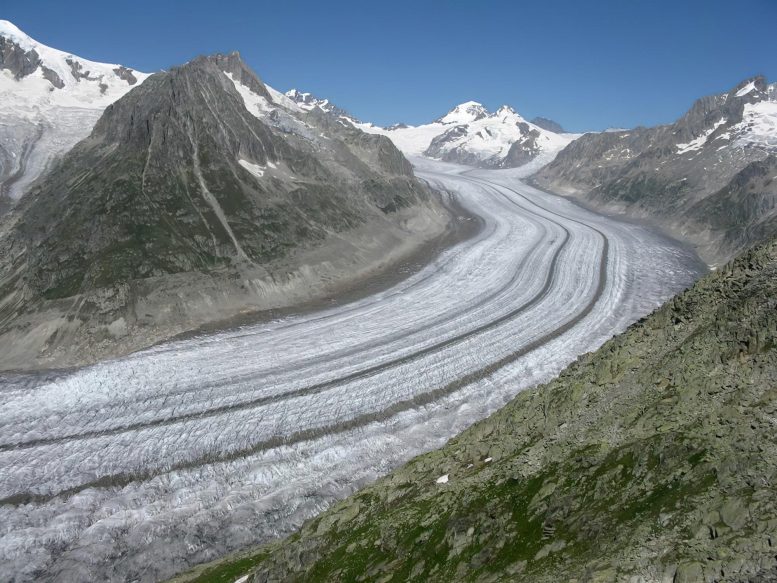
A study by the University of Lausanne and partners predicts a 34% loss in the European Alps’ ice volume by 2050 if global warming stops now, and up to 65% loss if current trends continue, using advanced AI models for more immediate projections. The Aletsch glacier in 2009, in Switzerland. Credit: UNIL – Guillaume Jouvet
Even if global warming were to stop entirely, the ice volume in the European Alps is projected to decrease by 34% by 2050. Should the pattern observed in the past two decades persist, the ice loss could approach nearly half of its current volume, according to a recent international study led by scientists at the University of Lausanne (UNIL, Switzerland).
By 2050, i.e. in 26 years time, we will have lost at least 34% of the volume of ice in the European Alps, even if global warming were to stop completely and immediately. This is the prediction of a new computer model developed by scientists from the Faculty of Geosciences and Environment at the University of Lausanne (UNIL), in collaboration with the University of Grenoble, ETHZ, and the University of Zurich.
In this scenario, developed using machine-learning algorithms and climate data, warming is stopped in 2022, but glaciers continue to suffer losses due to inertia in the climate-glacier system. This most optimistic of predictions is far from a realistic future scenario, however, as greenhouse gas emissions continue to rise worldwide.
In reality, more than half the volume of ice will disappear
Another more realistic projection from the study shows that, without drastic changes or measures, if the melting trend of the last 20 years continues, almost half (46%) of the Alps’ ice volume will actually have disappeared by 2050. This figure could even rise to 65%, if we extrapolate the data from the last ten years alone.
2050: the near future
Unlike traditional models, which project estimates for the end of the century, the new study, published in Geophysical Research Letters, considers the shorter term, making it easier to see the relevance in our own lifetimes and thus encouraging action. How old will our children be in 2050? Will there still be snow in 2038, when Switzerland may host the Olympic Games? These estimates are all the more important as the disappearance of kilometers of ice will have marked consequences for the population, infrastructure, and water reserves.
“The data used to build the scenarios stopped in 2022, a year that was followed by an exceptionally hot summer. It is therefore likely that the situation will be even worse than the one we present,” states Samuel Cook, a researcher at UNIL and first author of the study.
Artificial intelligence boosts models
The simulations were carried out using artificial intelligence algorithms. The scientists used deep-learning methods to train their model to understand physical concepts and fed it real climate and glaciological data. “Machine learning is revolutionizing the integration of complex data into our models. This essential step, previously notoriously complicated and computationally expensive, is now becoming more accurate and efficient,” explains Guillaume Jouvet, prof. at the FGSE and co-author of the study.
Reference: “Committed Ice Loss in the European Alps Until 2050 Using a Deep-Learning-Aided 3D Ice-Flow Model With Data Assimilation” by Samuel J. Cook, Guillaume Jouvet, Romain Millan, Antoine Rabatel, Harry Zekollari and Inés Dussaillant, 1 December 2023, Geophysical Research Letters.
DOI: 10.1029/2023GL105029









Every system is decades past the tipping point and our meager carbon agreements will not do anything to halt what is coming.
The evidence for your claim?
To think we have control over a planetary scale system is foolish at best and catastrophic at worst.
History is all we need to look at, no other evidence needed. The more we try to control the climate the worse we will make things.
The planet is a gigantic organism and has self healing methods built in just like we have our immune system.
Now about the Himalayan glaciers, the water reservoirs for between 2 and 3 billion people……..
Consider that if it should turn colder, and the glaciers started advancing, that there would be less water for those 2-3 billion people because there would be reduced melting. Nothing is constant over time, despite it appearing so to short-lived humans. Long-term, mountains rise and are eroded away. Glaciations come and go and, surprisingly, so so do warm periods.
“Even if global warming were to stop entirely, the ice volume in the European Alps is projected to decrease by 34% by 2050.”
Nothing is certain in life except that each and every one of us will eventually die. What is the probability of the projection happening? What is the range of that probability? What are the error bars on the estimate of 34%? A fortune teller doesn’t give probabilities either because then those paying to be told their future would have a metric by which to judge the ‘projection.’ These kinds of projection numbers, without error bars, are in the same category as reading tea leaves or looking into the interior of a cracked crystal ball.
“This essential step, previously notoriously complicated and computationally expensive, is now becoming more accurate and efficient,”
It sounds like the good professor hasn’t tried any of the available interactive AI interfaces such as ChatGPT. They commonly provide incorrect information, some based on unsupported consensus, and at other times, actually fabricating the facts and sources. While they readily admit to their mistakes if challenged, there is no evidence that they actually learn from their mistakes. As is typical with the science of today, there are a lot of unstated assumptions hiding behind the curtain.
Having read the actual paper, and not just the press release, nowhere do I find the conventional reporting for scientific papers of a nominal or average value with an associated +/- 2-sigma (or even 1-sigma!) uncertainty. They don’t even report the r^2 value for the linear regression they use to extrapolate to 2050. If they were to take the standard deviation of all the ensemble estimates (de-trended or not), not an unreasonable procedure considering the high variance of all the runs, I suspect that a 2-sigma uncertainty would be so large as to make the modeling exercise appear ludicrous. Perhaps that explains why they did not report actual statistics and, instead, resorted to subjective qualifiers such as “small.” That is inversely analogous to the fisherman’s friend asking “How big?” after listening to his friend describe the ‘big one’ that got away. I’m surprised and disappointed that this paper made it through peer review.